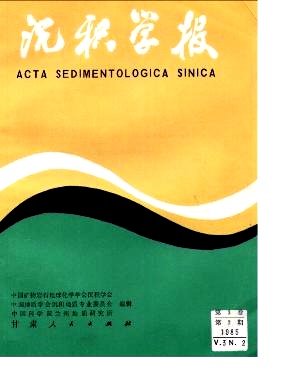STUDY ON THE RELATIONSHIP BETWEEN THE CHARACT- ERISTICS OF CARBONATE FACIES OF THE UPPER AND MIDDLE DEVONIAN SERIES AND MINERALIZATION OF LEAD-ZINC DEPOSITS IN SIDING-GUDAN DISTRICT, GUANGXI
- Publish Date: 1985-06-10
Abstract: Based on the survey, analysis, correlation of systmatic facies section, transverse trace of outcrops, and study in the laboratory, the carbonate strata of the Upper and Middle Devonian Series in this area may be classified into two facies regions, three facies belts and six microfacies. (1) The continental margin facies region with al'ittoral facies belt which can be subdivided into a supratidal local swamp facies and a littoral terrigenous clastic shoal facies. The basic characteristic of the littoral local swamp facies is that it consists chiefly of thin beded, carbonaceous shales and micrites. In the latter there are abundant shell fossils and coral fragments together with mud-crack and birdseye structures, knotty and banded limestones are common. The littoral terrigenous clastic shoal facies is a set of coarse clastic rocks-mainly calcareous-quartz sandstones, sandstones with gravels, conglomerates and minor siltstones, containing more marine fossils. Glauconite occurs ubiquitously in these rocks. Gentle "teepee" type cross bedding and ripple bedding occur in sandstones and siltstones, they are generally reverse-graded beddings. The platform facies region contains a restricted platform facies belt and an open platform facies zone. The restricted platform facies belt can be divided into an intertidal mud flat facies and a tidal channel bar facies. The former is the most developed and consists essentially of two rock types, i.e. the first is chiefly made of limestones, which consist mainly of thin to medium beded micrites with widely developed laminated limestones and a few intercalated psephitic limestones. They are possessed of lenticular bedding, birdseye structure, etc and few fossils. The second is composed mainly of dolomites, which are considered to be formed in diagenetic stage. Relict and metasomatic-relict structures are widely developed in the rocks. Based on their structures, the original rocks restored were domina- tively micrites and lamellar limestones. The dolomites, as a petrographic unit, are regionally distributed. The tidal channel bar facies is in locally intermittent distribution. The tidal channel subfacies is characterized by oncoid limestones intercalated with bioclastic limestones,grainstones, etc, while the bar subfacies by oolite-bearing psammitic limestone, psammitiic limestone, psephitic limestone and bioclastic limestone with subaqueous scour planes. The open platform facies belt consists of a backshoal open platform facies and an intraplatform oal-biosh facies.In the former predominate micrite,algal pellet limestone and grainstone with abundant fossils and horizontal stratifications. The latter was the accumulation of bioclasts-mainly branched and massive Stromatopora. Based on the observation, these organisms grew in situ or were transported in a short distance. The abundance of lead and zinc of carbonate strata in this generally 3 to 4 times higher than the Clark Value of lead and zinc in carbonate, rocks even amounting to 6 times higher than that. The intertidal mud-flat facies about 300-meter thick is considered to control lead and zinc mineralization zone. According to the syntesis of other data, the authors infer that brines and metals for the lead and zinc mineralization were provided by the Intertidal mud-flat,facies, which was the main source-bed.
| Citation: | Yang Chuxiong, Fu Tongyi, QinHuanran. STUDY ON THE RELATIONSHIP BETWEEN THE CHARACT- ERISTICS OF CARBONATE FACIES OF THE UPPER AND MIDDLE DEVONIAN SERIES AND MINERALIZATION OF LEAD-ZINC DEPOSITS IN SIDING-GUDAN DISTRICT, GUANGXI[J]. Acta Sedimentologica Sinica, 1985, 3(2): 97-107. |






 DownLoad:
DownLoad: